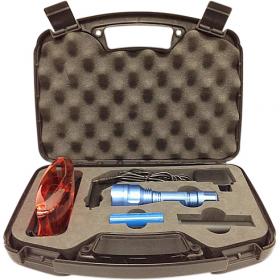Technical Data Sheet
Leak Detection Instructions & Info
It is important to keep in mind that leaks in a baghouse do not necessarily point to leaking or faulty filter bags. Detect- A-Leak identifies leaks in seals, as well as hairline cracks in the tubesheet and at weld points – structural leaks that otherwise often cannot be detected at all unless they are clearly obvious.
► Pink — good in all industries
► Green — aluminum, cement, utilities
► Yellow — all industries except where sulfur is present
► Orange — all industries except where iron oxide is present
► Blue — all industries except where dust color is very light
► Purple — all industries except where dust color is very light
Benefits
► Identifies bag failures early
► Assures effective start-up
► Decreases downtime
► Simple and easy process
► Easily seen with ultra-violet light
► Safe, non-hazardous formula
► Highly engineered product designed for high visibility
Step 1: [diameter] in x π (3.14) = [circum]
Step 2: [Step 1 result] x [length] = [circum] in2
Step 3: [Step 2 result] in2 = _______ ft2 144 in2
Step 4: _______ bags x _______ ft2 = _______ ft2 cloth area
Step 5: _______ ft2 / 1000 = lbs. of compound
Using Leak Detection Powder
Operating Instructions
- Locate a convenient position on the ductwork that is on the suction side of the fan. The port should be at least 3” in diameter. The simplest means of injection is to install a 4” pipe nipple with a cap onto the duct.
- Shut off the cleaning mechanism, start the fan and introduce the compound in the mixture of 1 lb. for every 1,000 ft.2 of filter area. It is best to turn off the bag cleaning mechanism in order to leave a dustcake on the filter bags. The resulting high pressure differential between the clean and dirty side of the bags will encourage the compound to flow through any holes. Injecting the leak detection compound should take about one minute. Allow the fan to run no more than 30 seconds after injection of the tracer compound.
DO NOT operate the cleaning mechanism during or after the injection of the leak detection compound.
- Shut off the fan and inspect, using the black light.
For pulse type units, inspection involves opening the top door and shining the light over the clean air plenum.
For shaker or reverse air units, inspection takes place from the inside, starting with the lower level and concentrating the light around the cellplate and thimbles.
Make sure you have more than one color on hand in order to verify leak repairs!
Having trouble finding the leaky bags in your collector?
► Flashlight has four LEDs
► Beam angle approximately 15 degrees
► Quartz diffusing for a smooth beam output
► DimensionsL 5.25″ long x 2.25″ wide
